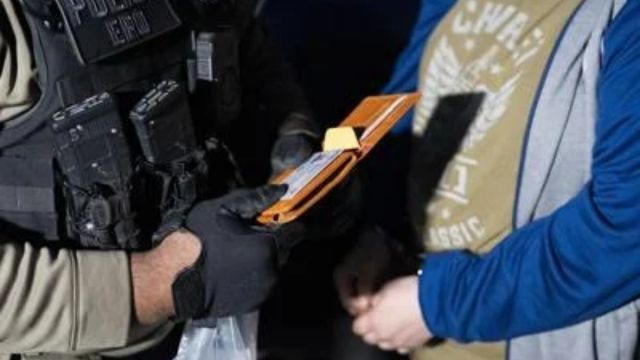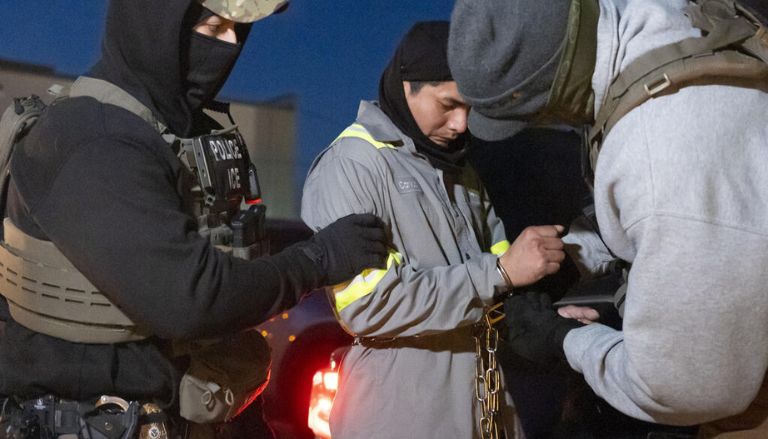Silver Spring, Maryland — A week into Donald Trump’s second term, federal officers are focused on stopping illegal immigration, understanding that no one will be let off the hook anymore.
Early Monday morning, twelve officers from Immigration and Customs Enforcement met in a parking lot in Maryland. They then spread out across the Washington suburbs to look for specific individuals: someone wanted for murder in El Salvador, a person who had been convicted of armed robbery, a migrant found guilty of having child sexual abuse material, and another individual with drug and gun convictions. They were all in the country without permission.
Matt Elliston, head of ICE’s Baltimore office, said that they prioritize the worst offenders first when enforcing the law.
The Associated Press went along with the officers to show how their jobs have changed since the White House decided to deport many foreigners living in the U.S. without permission.
Elliston said that issues related to public safety and national security are still the main focus.
This is similar to what happened under the Biden administration, but there has been a significant change: Under Trump, officers can now arrest people who don’t have legal standing if they find them while searching for migrants who are supposed to be removed. Joe Biden has banned “collateral arrests.”
“We’re searching for cases related to public safety and national security.” “The main difference is that no one gets a free pass anymore,” said Elliston.
He said that the number of collateral charges has varied. By the end of Monday across Maryland, ICE had arrested 13 people. Nine were intended targets, and the other four were people that ICE found during the morning.
One of those involved had a serious theft record. One person had already been deported once, and two others had been ordered to be removed for good.
Changes to immigration regulation during Trump’s presidency.
The administration noted that other agencies joined the immigration operations over the weekend. This includes the FBI, the Drug Enforcement Administration, and the Bureau of Alcohol, Tobacco, Firearms and Explosives, all of which are part of the Justice Department.
Emile Bove, the acting deputy attorney general, watched arrests in Chicago on Sunday. This shows that the Justice Department is getting more involved.
ICE made about 311 arrests each day on average until September 30. After Trump became president, the number of daily arrests remained about the same at first but then jumped significantly to 956 on Sunday and 1,179 on Monday. If this continues, it would be the highest daily rate recorded by ICE.
Trump has removed rules that used to prevent ICE from working in sensitive places like schools, churches, or hospitals. Many migrants and supporters are concerned that children might be scared if they see their parents get arrested when dropping them off at school. They also worry that migrants who need medical help might avoid going to the hospital because they are afraid of being arrested.
Elliston dismissed those concerns, noting that it’s very uncommon for ICE to go into those places. In his 17 years of work, he mentioned that he has only entered a school once, and that was to help deal with an active shooter situation.
He said that getting rid of other rules that limited ICE activities at courthouses is more significant for the agency’s job.
Removing the sensitive locations strategy impacts ICE in less obvious ways.
On Monday, the team paused in a parking lot to try to catch a Venezuelan gang member thought to be working as a delivery driver for a nearby store. There was a church across the street and an elementary school one street over. Following the old rules, this meant that parking nearby for monitoring was not allowed.
Some policing rules remain the same.
Elliston said that one thing remains the same: these operations are focused on specific targets. ICE has a specific list of people they are targeting instead of randomly searching workplaces or apartments for those in the country illegally.
“I don’t like the word ‘raids’ because it makes people think we’re just going from house to house asking, ‘Show us your papers,'” he said. “Nothing could be further from the truth.”
Since Trump took office again a week ago, Elliston said he’s been on the phone a lot, trying to clear up rumors about ICE’s actions and who is being taken.
Since he began his job in 2022, Elliston has been trying to establish connections with elected leaders and law enforcement agencies in Maryland. Many communities in the state have sanctuary policies that restrict their cooperation with federal immigration authorities.
Elliston has contacted towns to provide information about what ICE does and who its officers are looking for. He works on building good relationships with city officials so they feel more at ease informing authorities when detained migrants are about to be freed. This allows ICE to capture them.
What else has stayed the same? Sometimes when searching for someone, you might not find them.

In an apartment building in Takoma Park, near Washington, three ICE agents knocked on an apartment door, asking the person inside to come out.
“Miss, can you open up?” the officer said. “Could you come to the door so we can talk?” … “We need to keep returning until we fix this address.”
A man who lived in the apartment came home and spoke with the ICE officers. The person they were trying to find probably gave the cops the wrong address when he got arrested and didn’t actually live there.
If they can’t find someone, Elliston said, they continue searching.
He said, “I will never stop looking for these guys.”







Leave a Comment